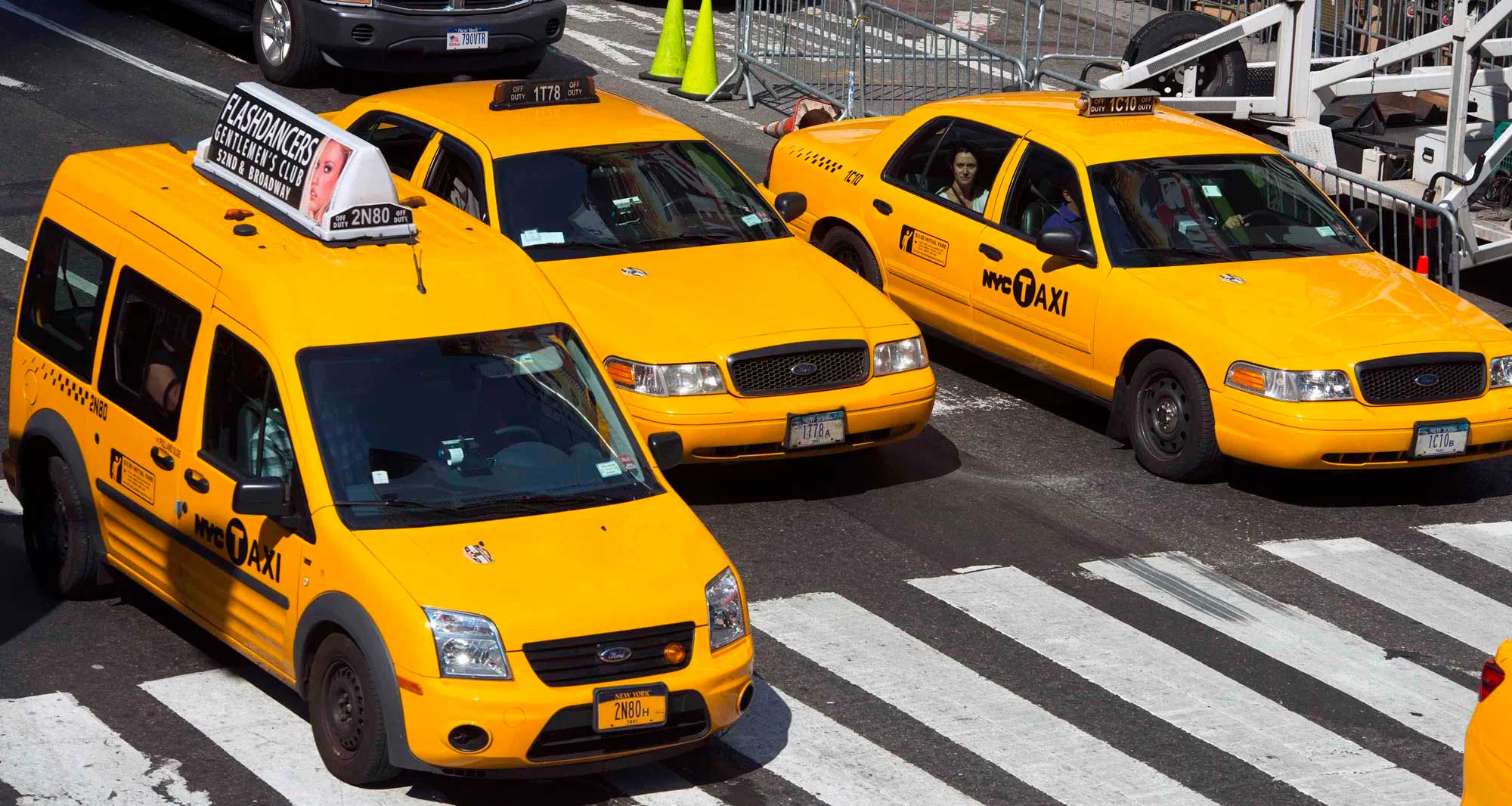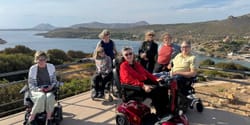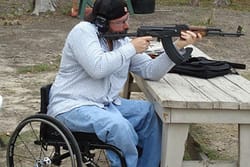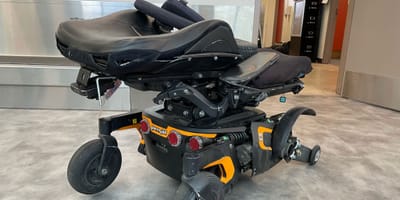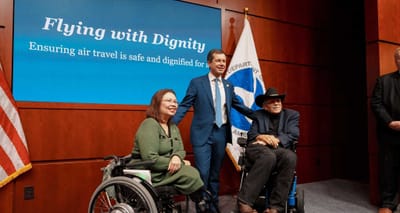Hailing a wheelchair accessible taxi cab from the street or sidewalk is possible in only a few cities around the world. Even in the United States, wheelchair taxis must often be reserved a day or more in advance, and there is no guarantee that one will ever show up.
In the last year, I have traveled to most major cities in the United States. With the exception of a few, like Chicago, Las Vegas and New York City, access to ADA compliant taxi vans is hit or miss at best. The Americans with Disabilities Act does not go far enough in regulating private transportation companies, and fails at enforcing the regulations that are laid out in the law. The failure of governments to enforce the civil rights of the disabled, coupled with the willingness of taxi companies to violate those rights, challenges the very notion of equality in America. The ADA mandates the following concerning private transportation and taxi companies:
Sec. 37.103 Purchase or lease of new non-rail vehicles by private entities primarily engaged in the business of transporting people.
(a) Application. This section applies to all acquisitions of new vehicles by private entities which are primarily engaged in the business of transporting people and whose operations affect commerce, in which a solicitation for the vehicle is made (except as provided in paragraph (d) of this section) after August 25, 1990.
(c) Demand responsive systems. If the entity operates a demand responsive system, and purchases or leases a new vehicle other than an automobile, a van with a seating capacity of less than eight persons (including the driver), or an over-the-road bus, it shall ensure that the vehicle is readily accessible to and usable by individuals with disabilities, including individuals who use wheelchairs, unless the system, when viewed in its entirety, meets the standard for equivalent service of Sec. 37.105 of this part.
(d) Vans with a capacity of fewer than 8 persons. If the entity operates either a fixed route or demand responsive system, and purchases or leases a new van with a seating capacity of fewer than eight persons including the driver (the solicitation for the vehicle being made after February 25, 1992), the entity shall ensure that the vehicle is readily accessible to and usable by individuals with disabilities, including individuals who use wheelchairs, unless the system, when viewed in its entirety, meets the standard for equivalent service of Sec. 37.105 of this part.
Sec. 37.105 Equivalent service standard.
For purposes of Sec. Sec. 37.101 and 37.103 of this part, a fixed route system or demand responsive system, when viewed in its entirety, shall be deemed to provide equivalent service if the service available to individuals with disabilities, including individuals who use wheelchairs, is provided in the most integrated setting appropriate to the needs of the individual and is equivalent to the service provided other individuals with respect to the following service characteristics:
(a) (1) Schedules/headways (if the system is fixed route); (2) Response time (if the system is demand responsive);
(b) Fares;
(c) Geographic area of service;
(d) Hours and days of service;
(e) Availability of information;
(f) Reservations capability (if the system is demand responsive);
(g) Any constraints on capacity or service availability;
(h) Restrictions priorities based on trip purpose (if the system is demand responsive).
The seating capacity of passenger mini-vans is seven. This means that a private taxi company that purchases or leases a new van must make that van wheelchair accessible, with ramps. The exception to this rule relates to “equivalent service.” According to the parameters outlined in section 37.105, an equivalent service must be wheelchair accessible and have the same response time, fares and hours of service.
Let me provide examples of cities and taxi companies which I have found to be in violation of the equivalent service mandate. These have been drawn from my own, recent travel experiences:
St. Louis, Missouri: Following a May 2015 St. Louis Cardinals baseball game, I requested a wheelchair accessible taxi to take me back to my hotel. None of the local taxi companies could provide one, with one company, A-Best Taxi Service, saying they would be unable to dispatch one until the next day. That taxi company was operating other cabs at the time of my call, including many late model vans that were not wheelchair accessible.
Ft. Lauderdale, Florida: After a late dinner, followed by drinks, at approximately 11:00 p.m., I called for a wheelchair accessible taxi to take me from a restaurant in downtown Ft. Lauderdale to my hotel several miles away. Yellow Cab was not able to provide a cab, despite there being countless taxis on the road and in service. I waited for nearly three hours, until 2:00 A.M., when a wheelchair taxi began accepting calls. This three-hour wait was a violation of the response time requirement outlined in Sec. 37.105 of the ADA.
Los Angeles, California: I called United Taxi to pick me up from Mass on a Sunday afternoon. I was quoted 20 minutes, but the cab did not arrive until 45 minutes after I had requested the taxi. This extended wait time was not equivalent the wait time an able-bodied passenger would have faced.
What is “Equivalent Service?” By the letter of the law, it should mean that any taxi company that has added a new van to its fleet since February 1992 make that van wheelchair accessible. If they do not, they must ensure that they are able to dispatch a wheelchair accessible vehicle in the same amount of time as a vehicle that is not accessible.
If I am standing on the corner of 1st & Main in Anywhere, U.S.A., I should receive a taxi in the same amount of time as John Doe standing next to me. That is the law. Unfortunately, I may often be standing there far longer than John Doe, sometimes unable to get a taxi at all.
In all of my travels, I have found only one city that meets the equivalent service standard. That city is not in the United States – it is London, England. In London, every taxi is equipped with a wheelchair ramp and has the ability to transport passengers in manual or powered wheelchairs.
In Shanghai, China, I have been able to get a wheelchair taxi with by calling ahead. That’s more than I can say for St. Louis, where a wheelchair taxi has never been available in the 10 or more times I have called for one.
The problem in America is simple – no one is enforcing the ADA as it relates to private transportation and taxi companies. A disabled person’s only recourse is a private lawsuit. You can certainly write to local governments, but that will do little good if there is no one in city government willing to stand for your rights.
The Americans with Disabilities Act looks good on the surface, but it has no teeth. Private businesses and local governments can get away with violations if citizens do not hold their feet to the fire through legal action. As a guy who actually lost his feet in a fire, I don’t have the time or the energy for that. I suspect the more than 1% of the U.S. population in wheelchairs don’t either. The refusal of governments to enforce the ADA and the willingness of businesses to break the law forces the disabled into the shadows, making us the “invisible 1%.”
So, where do we go from here? Share your thoughts and experiences in the comments below.

